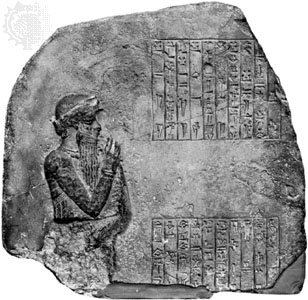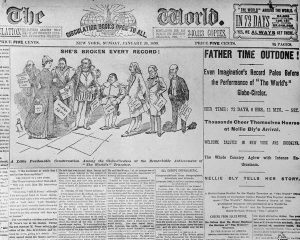Who would become the first king of the Babylonian Empire as well as gain fame for his creation of a law code? From conqueror to administrator, Hammurabi ruled over the Babylonian Empire during the years from 1792 to 1750 B.C.E.1 Hammurabi improved upon the techniques that the Akkadian ruler Sargon I had used previously to govern, which included bureaucratic rule and regular taxation.2 The most influential contribution on behalf of Hammurabi was his code of law. Although Hammurabi introduced the code towards the end of his reign, it was nonetheless influential.
Mesopotamian Law at that time was the most extensive form of law to have existed.3 The code helped Hammurabi establish order between all the diverse groups of people under his control. After conquering various groups of people, Hammurabi needed to bind these different groups together.4 Hammurabi gathered his people at the city of Babylon and unveiled a stele (stone slab).5 Hammurabi claimed to have come upon the laws through the god of Babylonian justice, Shamash. It was Hammurabi’s belief that the god had chosen him to deliver the laws to his people.6 The stele contained 282 laws to govern the people of his empire.7
Furthermore, the laws dealt with a variety of aspects of human life within the empire. The code illustrated major and minor offenses as well as their punishments. More often than not, the punishments were either death or a monetary fine. The code was written in cuneiform (a writing form adopted from the Sumerians), but the laws were carved in the Akkadian language. An example of the kinds of laws the Code contains can be seen in its first statute: “If a seignior accused a[nother] seignior and brought a charge of murder against him, but has not proved it, his accuser shall be put to death.”8 A monetary example is rule number two-hundred twenty: “If [a physician] opened his eye-socket with a bronze lancet and has destroyed his eye, he shall pay one-half his value in silver.”9
It is important to note that the Hammurabi Code made a strong distinction between social classes. For example, in sections 196 to 199 the Code reveals the application of the legal principle lex talionis (Latin for law of retribution). When a seignior (free man) commits a wrong to another seignior, the penalty was that the same infraction would be administered upon the perpetrator.10 However, if a seignior committed that same wrong to someone of a lower social class, the accused seignior did not have the same wrong attributed back. However, if a poor man is wronged, then one can simple pay a fee. Evidence for the social distinction is illustrated well with rules 196 and 198. Rule 196 states, “If a seignior has destroyed the eye of a member of aristocracy, they shall destroy his eye.”11 However, on the other hand, rule 198 states, “If [a seignior] has destroyed the eye of a commoner or broken the bone of a commoner, he shall pay one mina of silver.”12 It is believed that the typical phrase “an eye for an eye” became the core principle for Hammurabi’s Code. The slaves were even below the other two classes as evidenced with rule 199, which states, “If [a seignior] has destroyed the eye of a seignior’s slave or broken the bone of a seignior’s slave, he shall pay one half his value.”13

The stele containing the law code was displayed out in the public. The purpose was so that everyone could see the law. However, there was a slight issue: most people at that time were not literate. Therefore, although the law was displayed, very few were actually able to read and comprehend it. The rich and elite were favored while the poor and women were not treated equally. As a result, the Code became a reflection of the distinctions between the social classes, and between gender roles as well.
Hammurabi’s code would appear to be quite controversial and simplistic in the view of modern society. However, the code proved to be effective throughout Hammurabi’s reign. A point of controversy that arises from Hammurabi’s Code is the wording within the code. As opposed to modern law’s use of statements such as “this is not allowed” or “it is illegal to…” Hammurabi’s Code pursued more of “action X results in consequence Y.”14 An example to illustrate such process is as follows: if someone steals something (action X) the result is the death of the accused (consequence Y).
Although society has now progressed beyond the time of Hammurabi in several aspects of human society such as in law, it is important to analyze the roots of those developments. Furthermore, there also lies importance in drawing similarities between the past and modern society. How does modern society differ from Hammurabi’s in terms of social status and laws? Does modern law treat everyone equally in society? If not, then what similarities does modern society share with Hammurabi’s time? Human society is able to gain insight into the origins of contemporary social, political, economic and cultural problems.
- Ronald Wallenfels, ed., “Hammurabi,” in World Eras, vol. 8, Ancient Mesopotamia, 3300-331 B.C.E. (Detroit: Gale, 2005), 283. ↵
- Jerry H. Bentley, Herbert F. Ziegler, and Heather E. Streets-Salter, Traditions & Encounters: A Brief Global History, Fourth, vol. 1 (New York, NY: McGraw-Hill Education, 2016), 10–12. ↵
- Don Nardo and Robert B. Kebric, eds., “Hammurabi (Reigned Ca. 1792–1750 B.C.),” in The Greenhaven Encyclopedia of Ancient Mesopotamia (Detroit: Greenhaven Press, 2007), 134–35. ↵
- Brian Bonhomme and Cathleen Boivin, eds., “Code of Hammurabi,” in Milestone Documents in World History: Exploring the Primary Sources That Shaped the World, vol. 1, 2350 BCE – 1058 CE (Dallas, TX: Schlager Group, 2010), 16. ↵
- Jennifer Stock, ed., “Hammurabi Establishes a Legal Code,” in Global Events: Milestone Events Throughout History, vol. 5, Middle East (Farmington Hills, MI: Gale, 2014), 38–40. ↵
- Jennifer Stock, ed., “Hammurabi Establishes a Legal Code,” in Global Events: Milestone Events Throughout History, vol. 5, Middle East (Farmington Hills, MI: Gale, 2014), 38–40. ↵
- James B. Pritchard, ed., Ancient Near Eastern Texts Relating to the Old Testament, Third Edition (Princeton, NJ: Princeton University Press, 1969) 177. ↵
- Pritchard, ed., Ancient Near Eastern Texts, 166. ↵
- Pritchard, ed., Ancient Near Eastern Texts, 175. ↵
- Alfred J. Andrea and Carolyn Neel, eds., “Hammurabi’s Law Code and the Tripartite Structure of Mesopotamian Civilization,” in World History Encyclopedia, vol. 3, Era 2: Early Civilizations, 4000-1000 BCE (Santa Barbara, CA: ABC-CLIO, 2011), 150–51. ↵
- Pritchard, ed., Ancient Near Eastern Texts, 175. ↵
- Pritchard, ed., Ancient Near Eastern Texts, 175. ↵
- Pritchard, ed., Ancient Near Eastern Texts, 175. ↵
- Bonhomme and Boivin, eds., “Code of Hammurabi,” in Milestone Documents in World History: Exploring the Primary Sources That Shaped the World, vol. 1, 2350 BCE – 1058 CE, 18. ↵



33 comments
Edgar Ramon
Excellent article, Hammurabi’s code was a great advancement towards a legal system that we have today. I also appreciate how you mentioned that the type of laws found in the code would be seen as simplistic and controversial in the current times. Because this code, just as that of the Romans, was a work in progress. Perhaps this putting people to death was the only way to keep the peace at the time of Hammurabi, we have come a very long way from that, although we still put people to death, it’s much less frequent.
Iris Henderson
I was interested to learn more about Hammurabi’s Laws because we discussed the topic lightly in class. It was interesting to see how differently the law is enforced on the poor versus the wealthy. Although we would like to think much has changed, I am not sure that it has. There reamains a high level of injustice and discrimination towards poor people, people of color, and women within our justice system.
Matthew Wyatt
I find this article fascinating. As a strong proponent for the rule of law, it’s important to understand that early iterations of systems of law such as this served to further subjugate lower classes rather than to provide for some semblance of equal protection. As the article suggests, echos of this conundrum exist even in the laws of modern society. Although the article is interesting, I would recommend a full rewrite of the final paragraph. The questions without answers leave the article feeling incomplete and the final sentence makes the conclusion feel jarring and abrupt rather than inspiring further contemplation.
Kailan Pena
I have heard of this specific set of laws before so the topic isn’t necessarily to me, although the information that i being provided regarding it is very descriptive and useful. I wonder if Hammurabi ever realized how important these laws would become to history, and it’s kind of funny that most of the people he reigned over couldn’t even read the rules he wrote.
Alexandra Cantu
I previously had heard of Hammurabi’s code but I had didn’t know they’re were so many laws, 282 laws to be exact. The most famous and used in the Bible is “eye for an eye”. I know now that in some countries in the Middle East still go by this law. It is so unfair how each class had specific rules and regulations. Though the poor slaves and women had little to no rights. If we really think about it, Today isn’t so different women are still considered below men and poor is never treated fairly.
Michael Thomas
I found this article interesting because of how Hammurabi’s code of law governed the people. Hammurabi’s code of law was based on status. If person had a high status, they would get away by just paying a fine. Society has improved over a course of time since Hammurabi’s code. The issue with his code of law was that it viewed women as property.
Caroline Bush
This was a really great article! I always find Hammurabi’s code interesting because to me its the first example of a unfair justice system. While I do think that an eye for an eye is a fair punishment for someone that commits a crime, I believe that the law should be equal for everyone no matter what there social class. While I do think that modern society’s have made strives in equality we are still not at the point we should be. Overall this was a very well detailed article that I enjoyed reading about.
Regina De La Parra
I enjoyed reading the article because from it, we can compare how much our laws and way of seeing equality and justice has changed over time. I have always found it interesting how much common things such as law and life has changed through decades and decades. I remember learning about this in high school, but I never had heard examples of the actual rules and I am glad that this article includes them. Great article and research!
Ashley Tumlinson
In high school history class, this was one of my favorite topics so I was excited when we discussed this in the classroom here. I really enjoyed reading your article because it clearly described the differences in the codes, which I think tends to get lost in translation. It is crazy to think about how intense this law actually was because ‘an eye for an eye’ and ‘a tooth for a tooth’ is a far more extreme version of todays ‘Golden Rule’ of treating others the way you wish to be treated.
Edward Cerna
This was a fine article to read. I had learned about this in class and this definitely expanded my knowledge on the topic. Although Hammurabi meant good when he established his laws it was kind of unfair how the upper and lower class weren’t treated the same. Also like you said, most of the people were not even literate so they could not even understand what was on the stone slab.